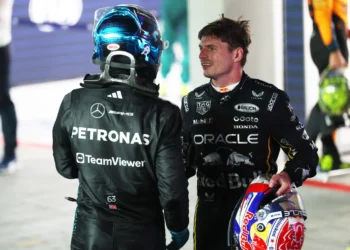Haas Team Principal Ayao Komatsu has raised the alarm bells over the controversial two-stop rule imposed by Pirelli for the upcoming Formula 1 Qatar Grand Prix, declaring it a recipe for disaster that could “destroy” the excitement of one of the sport’s marquee events. This bold new regulation, aimed at countering high tire degradation witnessed in previous races, has Komatsu questioning whether the Italian tire supplier is prioritizing fear over fairness.
Pirelli’s decision follows a tumultuous debut for the Qatar GP in 2021, where drivers faced catastrophic front-left tire failures amid the demanding high-speed corners and harsh surface of the Losail International Circuit. The subsequent races only confirmed the tire concerns, leading Pirelli to impose a stringent pit stop limit. This year, the rule dictates that drivers must make their tire changes within a mere 25 laps during the 57-lap race. Such restrictions, Komatsu argues, are nothing short of artificial and ultimately detrimental to the competitive spirit of Formula 1.
In a fiery critique, Komatsu stated, “I don’t agree with those artificial limits, but I guess it’s just Pirelli scared from last year, right? One-stop race, and Pirelli probably thought, ‘Surely they’re not going to go this time. Oh no, they’re going.’” He elaborated on the dangers of forcing teams into a predetermined pit strategy, emphasizing that the thrill of racing lies in the unpredictability of tire performance and strategy—a sentiment echoed by fans and pundits alike.
Drawing parallels with the infamous Monaco Grand Prix earlier this year, where a similar two-stop mandate failed to deliver an engaging race, Komatsu lamented, “You saw that in Monaco this year as well. You know, you’re trying to really artificially force something, then you made it worse.” He further pointed to the lack of overtaking and strategic diversity in the 2023 Losail race, suggesting that the new rule will lead to a dull spectacle where pit stop windows align and excitement evaporates.
The Haas boss is not merely concerned with the immediate impact of the two-stop rule; he is also worried about the long-term implications for the sport. “You don’t need to look any further than Brazil and Mexico to see what kind of exciting race you could have when the tire performance is on the edge of one or two stops, or two or three stops,” he emphasized, advocating for a return to competitive racing where multiple strategies can thrive.
As the motorsport world gears up for the Qatar Grand Prix, Komatsu’s warnings resonate louder than ever. Will Pirelli heed the concerns of team principals, or will the two-stop rule continue to threaten the integrity and excitement of Formula 1 racing? Fans and drivers alike will be watching closely, hoping for a race that lives up to the thrilling legacy of Formula 1 rather than succumbing to the shackles of artificial regulations. The clock is ticking, and the stakes have never been higher!










